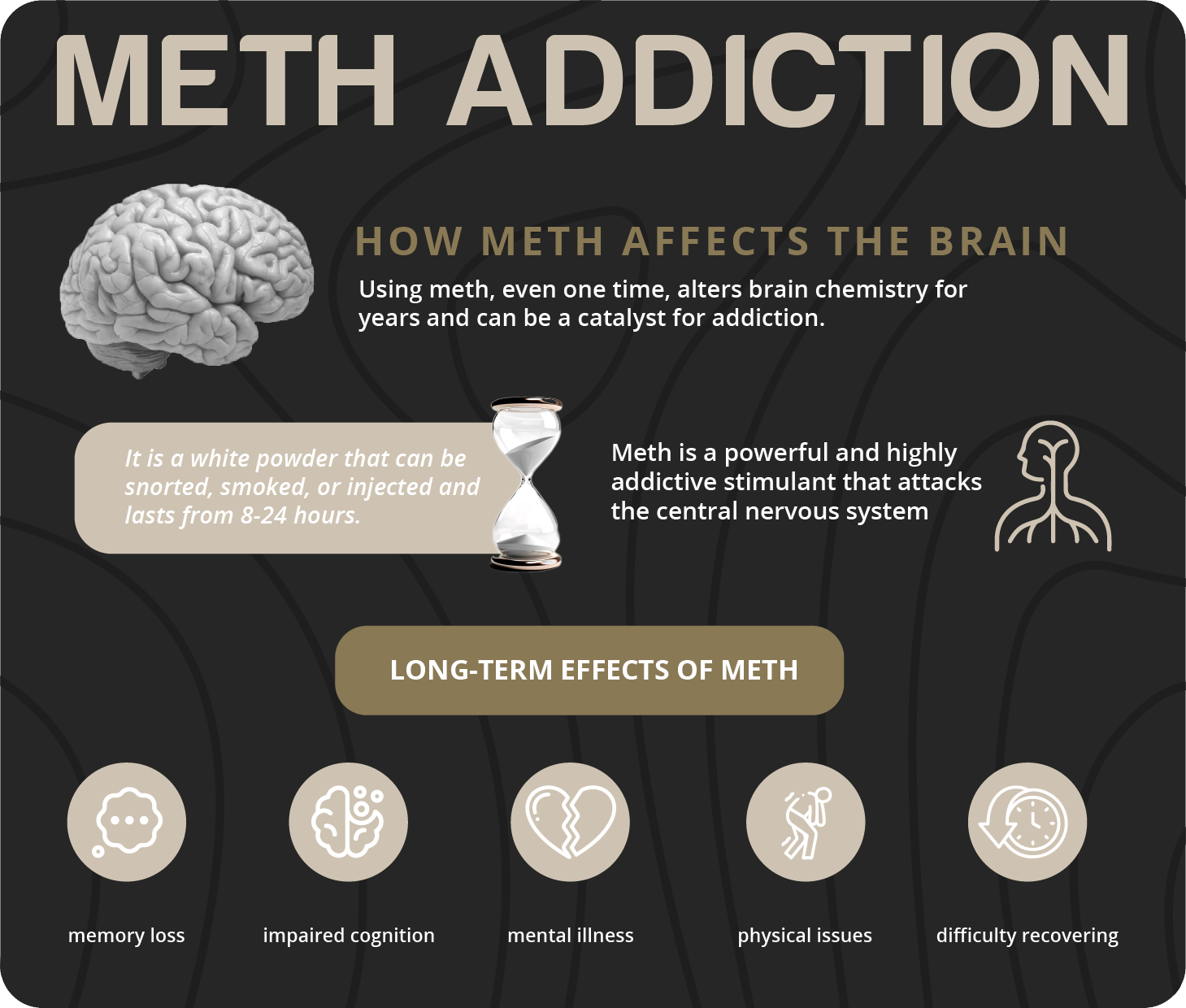The effects of methamphetamine can persist for varying durations, typically lasting anywhere from 8 to 24 hours after ingestion. But, the drug can leave traces in the body long after the immediate effects wear off. Methamphetamine can be detected in urine for up to 72 hours following use, making it a common method for drug screening.
Additionally, hair follicle tests can identify methamphetamine use for an extended period, with the drug remaining detectable in hair for up to 90 days after last consumption. These detection windows provide important information for drug testing programs and can play a crucial role in monitoring and assessing substance use habits.
Methamphetamine, commonly known as meth, is a powerful and highly addictive stimulant drug. It can have a significant impact on the body, both in the short term and the long term. If you or someone you know has been using meth, you may be wondering how long it can stay in your system.
What are the Immediate Effects of Meth?
 Meth can produce intense feelings of euphoria, increased energy, and heightened alertness. Some users may also experience a decreased appetite and a sense of increased confidence. However, these pleasurable effects are often short-lived and can be followed by a host of negative consequences.
Meth can produce intense feelings of euphoria, increased energy, and heightened alertness. Some users may also experience a decreased appetite and a sense of increased confidence. However, these pleasurable effects are often short-lived and can be followed by a host of negative consequences.
Immediate effects can include increased heart rate, elevated blood pressure, and irregular heartbeat. Meth can also cause extreme mood swings, insomnia, and anxiety. Additionally, users may experience a loss of coordination, confusion, and paranoia.
Long-term use of meth can lead to severe dental problems, hallucinations, and cognitive impairments. It can also increase the risk of developing mental health disorders, such as depression and psychosis.
It is important to note that methamphetamine is a highly addictive stimulant that affects the central nervous system. The drug works by increasing the release of dopamine in the brain, which is a neurotransmitter associated with pleasure and reward. This flood of dopamine can create a powerful rush of euphoria, leading users to seek out the drug repeatedly to experience the same intense high.
Furthermore, methamphetamine can have devastating effects on the physical appearance of long-term users. Chronic meth use is often associated with severe skin sores, known as “meth sores,” which result from users picking at their skin due to hallucinations of bugs crawling beneath the surface. These sores can be painful, unsightly, and prone to infection, further deteriorating the user’s overall health.
What Factors Can Affect How Long Meth Remains in the Body?
Several factors can influence how long meth stays in your system. These factors include:
- Dosage: The amount of meth consumed can affect the drug’s clearance from the body.
- Frequency of use: Chronic and heavy use can result in meth accumulating in the body over time.
- Metabolism: Individual variations in metabolism can impact how quickly the body breaks down and eliminates meth.
- Hydration: Adequate hydration can facilitate the elimination of meth from the body.
- Overall physical health: Underlying medical conditions can affect the body’s ability to metabolize and eliminate drugs.
The way a person uses meth can also play a role in how long the drug remains detectable in the body. For instance, smoking or injecting meth can lead to a more rapid onset of effects compared to oral ingestion, potentially affecting the drug’s clearance rate.
Furthermore, factors such as age and body mass index (BMI) can impact how long meth stays in the system. Older individuals or those with higher BMIs may metabolize the drug at a different rate than younger individuals or those with lower BMIs, potentially prolonging the drug’s presence in the body.
Does the Method of Use Impact How Long Meth Stays in Your System?
The method of meth use can affect how long the drug stays in the body. Intravenous (IV) use of meth typically results in a more rapid onset of effects and a shorter duration of action. In contrast, oral ingestion or smoking meth can lead to a longer duration of action.
Regardless of the method of use, methamphetamine can have a significant impact on the body and can lead to severe physical and psychological consequences.
It’s important to note that the route of administration can also influence the intensity of methamphetamine’s effects. When meth is injected intravenously, it bypasses the body’s natural defense mechanisms and is quickly absorbed into the bloodstream, leading to a more intense high. On the other hand, when meth is ingested orally or smoked, the drug is absorbed more gradually, resulting in a slower onset of effects but a longer-lasting high.
Furthermore, the method of meth use can also impact the risk of addiction and overdose. Intravenous use is often associated with a higher risk of addiction due to the rapid and intense effects it produces. Additionally, injecting meth increases the risk of overdose, as the drug reaches the brain more quickly and in higher concentrations. In contrast, oral ingestion or smoking may be perceived as less risky, but they still carry the potential for addiction and overdose, albeit to a slightly lesser extent.
Time Frames for Different Types of Tests
Meth can typically be detected in the bloodstream for up to 24-48 hours after use. However, this detection window can vary depending on various factors, such as the individual’s metabolism and the drug’s dosage.
It is important to note that blood tests for meth are not commonly used for routine drug screenings. They are often reserved for specific circumstances, such as legal proceedings or medical emergencies.
When methamphetamine is consumed, it is rapidly metabolized by the body, with the liver playing a crucial role in breaking down the drug into its metabolites. These metabolites are then circulated in the bloodstream, where they can be detected through blood tests. The detection of meth in the blood can provide valuable information to healthcare professionals and law enforcement agencies regarding recent drug use.
Factors such as hydration levels, kidney function, and overall health can also influence how long meth stays in the blood. Individuals with compromised liver or kidney function may metabolize the drug at a slower rate, leading to an extended detection window. Additionally, chronic meth users may have traces of the drug lingering in their bloodstream for a longer period compared to occasional users.
Urine testing is the most common method used to detect meth in the body. The drug can generally be detected in urine for up to 3-5 days after use. However, heavy and prolonged meth use can lead to it being detectable for a longer period, sometimes up to a week or more.
It is worth mentioning that there are urine tests designed to detect methamphetamine specifically. These tests can differentiate between meth use and the use of other drugs that may produce similar metabolites.
Factors such as metabolism, hydration levels, and the amount of meth consumed can also influence how long the drug remains detectable in urine. For individuals with slower metabolism, the detection window may be extended, while those with faster metabolism may clear the drug from their system more quickly.
Additionally, it’s important to note that chronic meth users may retain the drug in their system for an even longer period due to its cumulative effects. This prolonged detection time is a concern for individuals undergoing drug testing, as it can impact their ability to pass a urine screening even after abstaining from meth use for several days.
Meth can be detected in hair samples for an extended period, even months after use. Hair tests can provide a historical record of drug use, as hair grows at an approximate rate of 0.5 inches per month. Therefore, a 1.5-inch hair sample can provide information on drug use over the past three months.
It is important to keep in mind that hair tests can offer evidence of meth use but cannot provide an exact timeline of when the drug was consumed.
Factors such as hair color, hair treatment, and the amount of melanin in the hair can also influence the detection window of meth in hair samples. For example, darker hair colors may retain drugs for longer periods compared to lighter hair colors due to higher melanin levels.
Additionally, external contaminants like hair products and environmental exposure to drugs can sometimes lead to false-positive results in hair tests, highlighting the importance of considering external factors when interpreting test results.
Methamphetamine, commonly known as meth, can be detected in saliva for a shorter duration compared to other bodily fluids. It is typically detectable for up to 1-4 days after use. However, the detection window can vary depending on various factors, including the frequency and amount of drug use. Factors such as individual metabolism and hydration levels can also influence how long meth remains detectable in saliva.
Saliva tests are often used in situations where immediate drug use needs to be confirmed, such as roadside drug testing. These tests can offer rapid results and are relatively non-invasive. The process involves collecting a saliva sample using a swab, which is then analyzed for the presence of methamphetamine or its metabolites. It is important to note that while saliva tests are convenient and provide quick results, they may not be as sensitive as other testing methods, potentially leading to false negatives in some cases.
Receive Meth Addiction Treatment at Westwind Recovery®
If you or someone you know is struggling with meth addiction, it is important to seek help as soon as possible. Westwind Recovery® is a leading addiction treatment center in Los Angeles, California, specializing in helping individuals overcome substance abuse.
Our compassionate and experienced team of professionals can provide personalized treatment plans that address the unique needs of each individual. From outpatient programs to aftercare support, Westwind Recovery® offers a comprehensive range of services to support lasting recovery.
Contact Westwind Recovery® today to learn more about our meth addiction treatment options and take the first step towards a healthier and drug-free life.

Dr. Deena is the Chief Clinical Officer of Westwind Recovery®, an award-winning outpatient treatment center in Los Angeles where she oversees the clinical and administrative program and treatment methods. Dr. Deena is a doctor of psychology and licensed clinical social worker since 1993. LCSW #20628. Originally from the East Coast, Dr. Deena has worked running treatment centers, worked as a therapist in psychiatric hospitals as well as school settings and currently has a thriving private practice in the LA area. Dr. Deena has appeared regularly on the Dr. Phil Show as an expert since 2003. She has also been featured on many other TV shows, podcasts and has contributed to written publications as well as podcasts.





